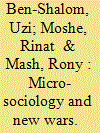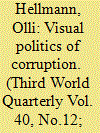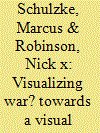| Srl | Item |
| 1 |
ID:
173762


|
|
|
|
|
| Summary/Abstract |
This study explores the “black box” of face-to-face violence during terror attacks. It is based upon visual analysis of a representative sample of terror attacks that occurred in Israel during 2015–2016, a period which is labeled “The Intifada of Individuals.” We offer a new method for this purpose by using available materials that military sociologists can retrieve and employ when they use the “macro”-level framework in their study of “micro”-level actions. The abundance of audiovisual devices allows a new perspective of belligerent friction typical of “New Wars.” Our methodology includes a combination of video and audio materials from open sources. Our analysis untangles the complexities of belligerency by minimizing the overall occurrences to the actions of the antagonist, the disrupter, and the crowd. We discuss our understandings for policy making concerning armament of civilians and overcoming the manipulation of terror attacks by media, government, and terrorists.
|
|
|
|
|
|
|
|
|
|
|
|
|
|
|
|
| 2 |
ID:
169120


|
|
|
|
|
| Summary/Abstract |
Despite the fact that corruption is essentially invisible, communication campaigns by the global anti-corruption industry regularly feature photographic images. So far, however, we do not know much about the narratives that are encoded in these images. Through the theoretical lens of postcolonialism, this paper takes a first step towards developing an understanding of the visual representation of corruption. Specifically, the paper applies semiotic and iconographic methods to two photography competitions run by Transparency International – the major non-governmental player in the anti-corruption industry. The analysis shows, first, that the anti-corruption industry reinforces colonial stereotypes, suggesting that the ‘sinful’ and ‘irrational’ Global South is waiting to be civilised by the North. Second, through its visual imagery, the anti-corruption industry also emphasises ideas of a ‘humanitarian family’, which serves to cover up the North’s role in transnational webs of corruption. These findings are triangulated with semiotic/iconographic analyses of the Transparency International logo and the Corruption Perceptions Index map.
|
|
|
|
|
|
|
|
|
|
|
|
|
|
|
|
| 3 |
ID:
150503


|
|
|
|
|
| Summary/Abstract |
Political scientists are increasingly engaged with the importance of the “visual turn,” asking questions about how we understand what we see and the social and political consequences of that seeing. One of the greatest challenges facing researchers is developing methods that can help us understand visual politics. Much of the literature has fallen into the familiar qualitative versus quantitative methodological binary, with a strong bias in favor of the former, and has consequently been unable to realize the advantages of mixed-methods research. We advance the study of visual politics as well as the literature on bridging the quantitative versus qualitative divide by showing that it is possible to generate quantitative data that is rooted in, and amenable to, qualitative research on visual phenomena. Our approach to conducting mixed-methods research is an alternative to the more common strategy of seeing various research methods as an assortment of tools, as it is directed at developing an organic relationship between qualitative and quantitative methods. We demonstrate the effectiveness of this strategy for research on visual politics by discussing our own efforts to create a dataset for quantifying visual signifiers of militarism.
|
|
|
|
|
|
|
|
|
|
|
|
|
|
|
|